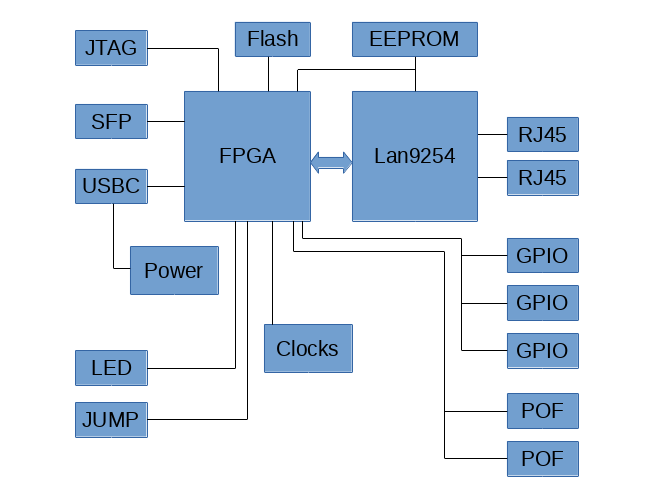Prototype board of the EtherCat EVR. This is intended to be a ESC implemented in an FPGA along with a Event Receiver. Power is supplied to this board via a USB-C (from a compatible port or power-supply/wal-wart).
At the core of this board is an Artix-7 FPGA which connects to an SFP from where it receives the timing-system event stream. A 16-bit parallel interface is connected to a LAN9254 EtherCat controller device which implements the low-level EtherCat functionality and drives a twin RJ-45 fast-ethernet connector (EtherCat bus).
The board hosts the following hardware:
- Artix-7 FPGA (xc7a35; note that this was the only device I could actually buy in 2022. Was able to secure the last 2 (!) chips from Mouser.
- Configuration flash device.
- Microchip LAN9254 EtherCAT controller. I also could only secure this device via Microchip's sample program (thanks!). At a cost of ~$10 it is cheaper and faster to use this controller rather than developing logic and implementing it in a (bigger!) FPGA device.
- Twin RJ-45 connector for EtherCAT. They are connected to the LAN9254 controller.
- EtherCAT ESC EEPROM. This holds the EtherCAT ESI data and embedded ("vendor-specific") non-volatile application parameters. These can be modified without having to regenerate a FPGA image/bitstream.
- SFP cage connected to an Artix-7 MGT.
- Renesas programmable VersaClock 6 clock generator (one of very few clock chip I could get a hand on in 2022). This is used as a refererence clock for the EVR MGT as well as a general-purpose clock for FPGA logic.
- Three LVTTL GPIO ports.
- Two POF I/O ports (these can drive an LED pulse-id display that can e.g., be used to verify camera real-time operation).
- Several LEDs and jumpers.
- Power-converters are fed from a single USB-C connector. The power-supply can be disabled from an FPGA-pin. This allows the user to implement features such as a watchdog or remote-control to self-power cycle the system.
- USB-2 FIFO interface to FPGA (FTDI FT240).
- JTAG interface connected to FPGA and (optionally) the LAN9254. Initial configuration of the FPGA (blank configuration flash) must be performed via this interface.
The choice of some components on the board may seem bizarre (e.g., the different types of voltage-regulators). The explanation is the shortage of devices in 2022; I had to scramble and in some cases obtain a small amount of samples from vendors and design with what was available.
